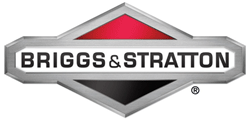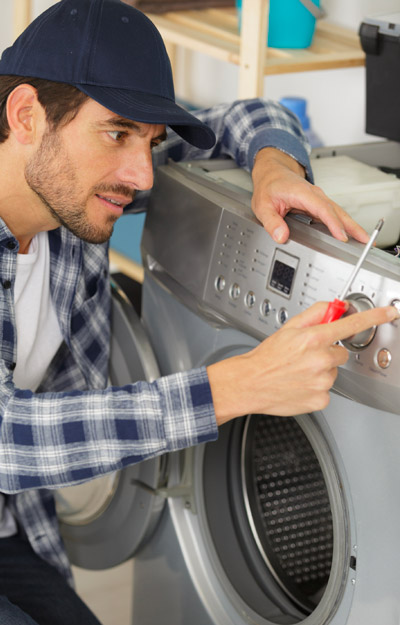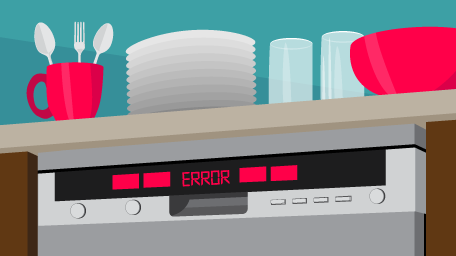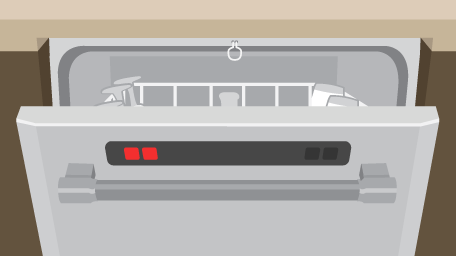Make sure you haven't got the discount earlier.

How to Fix a Frigidaire Dishwasher that Won't Drain
If you have noticed standing water in your dishwasher at the end of a cycle, unusually slow draining, or excessive gurgling sounds, then your dishwasher likely has a draining problem. If your Frigidaire dishwasher won't drain, it is most likely due to a blocked filter. Other common causes include blockages in the drain pump, drain hose, and garbage disposal, a faulty check valve or drain valve, or an improperly installed air gap. Whether you're a seasoned DIY enthusiast or new to DIY repairs, we'll help you understand how to diagnose and address drainage issues in your Frigidaire dishwasher to save you time, money, and the hassle of dealing with a malfunctioning appliance.
Signs Your Frigidaire Dishwasher is Not Draining Properly
- Standing Water: If you notice water pooling at the bottom of the dishwasher after a cycle has been completed, this is an indication that the appliance isn't draining properly.
- Foul Odors: If water is unable to drain from the dishwasher, bacteria and mold can grow rapidly, leading to unpleasant odors.
- Water Backup: If there is water backing up into the sink from the dishwasher drain during or after a wash cycle, then this is a sign that the air gap is blocked or there may be an obstruction in the drainage system.
- Dirty Dishes: If the wastewater produced during cleaning is unable to leave the dishwasher, it will be recirculated onto the dishes. This will leave your dishes with bits of debris on them or white spots. This is most often a sign of a clogged filter.
- Slow Drainage: If you notice that the water takes longer than usual to drain from the dishwasher, it could indicate a partial blockage in the drain system.
- Unusual Noises: A gurgling or humming sound coming from the dishwasher during the drain cycle can indicate a drainage issue, potentially caused by a clog.
- Error Codes: If your dishwasher displays the i20, i40, or iF0 error codes, this is an indication that there is a problem with the drain line or filter that is preventing water from flowing freely. You can check your dishwasher's manual for information on interpreting error codes.
How a Clogged Frigidaire Dishwasher Filter Causes Poor Drainage
The dishwasher filter is a component designed to catch food particles, debris, and other solid materials during the wash cycle to prevent them from recirculating onto dishes and clogging the dishwasher's pump or drain. A clogged filter is the most common cause of drainage issues. If the filter is blocked with food debris and other particles, water will be unable to flow out of the dishwasher at the end of the wash cycle. It is recommended to clean the dishwasher filter at least once a month. If the filter is damaged and no longer functioning then it will need to be replaced to fix the drainage problem. You can browse our list of genuine OEM Frigidaire dishwasher filters to find the right one for your model.
How to Clean a Blocked Filter to Fix Drainage Issues
- Disconnect the dishwasher from the power outlet and turn off the water supply.
- Open the dishwasher door and pull the bottom rack out of the dishwasher.
- Pull off the lower spray arm to access the filter.
- Press down on the locking tab to release the filter. Pull the filter out of the dishwasher.
- Carefully remove any large pieces of debris with your fingers and then use warm water and mild dish soap to clean any remaining residue.
- Thoroughly rinse the filter and wait for it to dry before returning it to the dishwasher.
- Once dry, reposition the filter inside the dishwasher and ensure it is locked in place.
- Reconnect the spray arm and slide the lower rack back in place.
- Reconnect the dishwasher to the power outlet and check that it is now functioning properly.
How a Blocked Frigidaire Dishwasher Drain Hose Causes Poor Drainage
The drain hose is a flexible tube that connects the dishwasher's drain pump to either the kitchen sink drain or the garbage disposal. It is responsible for transporting wastewater out of the dishwasher during the drain cycle. If the drain hose becomes kinked, or clogged with debris, it can obstruct the flow of water, preventing proper drainage from the dishwasher. Additionally, if the drain hose is damaged or cracked, it may leak water, which can also interfere with the dishwasher's ability to drain efficiently.
How to Clean a Blocked Drain Hose to Fix Drainage Issues
- Remove the access panel at the bottom of the dishwasher and locate the junction box.
- Note the orientation of the wire harness connected to the junction box and pull the wire connectors off.
- Unthread the screws from the mounting brackets that secure the dishwasher inside the cabinet opening.
- Locate the drain hose on your dishwasher. It's usually located at the back of the dishwasher, leading from the dishwasher tub to either the sink drain or garbage disposal.
- Pull the dishwasher forward to access the back of the appliance, where the drain hose is connected.
- Check that the hose is free of any kinks, twists, or sharp bends. If none are present, you will need to check the hose for obstructions.
- Disconnect the drain hose from the pump and the kitchen sink drain.
- Inspect the drain hose for any visible clogs or debris. Run high-pressure water through the hose to dislodge any stuck debris.
- If there are still clogs, you can use a long, flexible brush to gently scrub the inside of the hose. Make sure to use a brush that won't damage the hose material.
- Once the hose is clean, reconnect it to the dishwasher and the sink drain or garbage disposal. Make sure all connections are secure to prevent leaks.
- After reassembly, run a test cycle on your dishwasher to ensure everything is working properly and there are no leaks.
How a Blocked Frigidaire Dishwasher Drain Pump Causes Poor Drainage
The drain pump is responsible for pumping water out of the dishwasher during the draining cycle. It typically consists of a motor and impeller that creates suction to remove wastewater from the dishwasher and expel it through the drain hose. If the drain pump becomes clogged with debris, such as food particles or grease, or if it malfunctions due to wear and tear, it can prevent the dishwasher from draining properly. Additionally, if there are issues with the pump's motor or impeller, it may not be able to generate enough suction to effectively remove water from the dishwasher, resulting in standing water at the bottom of the dishwasher at the end of a cycle. You can find the drain pump located at the bottom of the unit.
How to Clean a Blocked Drain Pump to Fix Drainage Issues
- Begin by disconnecting the dishwasher from the power source and shutting off the water supply.
- Remove the screws that secure the front access panel at the bottom of the dishwasher.
- Disconnect the power wires connected to the junction box and remove the mounting screws that hold the dishwasher to the cabinet.
- Disconnect the drain hose from the sink drain or garbage disposal.
- Pull out the dishwasher and tip it over so that it is lying on its rear panel.
- Visually inspect the drain pump area for any visible debris or blockages. Remove any large debris you can reach with your fingers or a pair of tweezers.
- Use a screwdriver or pliers to remove any fasteners holding the drain pump in place, then carefully pull the drain pump out of its housing.
- Take a picture of how the wire connectors are routed and disconnect the wire connectors.
- Inspect the impeller for any obstructions or signs of damage.
- Use a soft brush or cloth to clean the impeller and the inside of the pump housing. Ensure that the impeller can spin freely.
- Once you've cleaned the drain pump and removed any blockages, you can reassemble the dishwasher in reverse order.
- Slide the dishwasher back into place, and restore power to the unit.
- Run a short cycle to test if the drain pump is working properly and if the blockage has been cleared.
How a Blocked Dishwasher Garbage Disposal Causes Poor Drainage
If you have recently installed the garbage disposal, make sure the knockout plug has been removed from the drain tube. This is often the most common cause of drainage issues in new dishwashers. If the garbage disposal is not new, then it may be blocked. If large amounts of grease, food particles, or other debris are regularly disposed of through the garbage disposal, they can accumulate over time, leading to blockages that affect drainage from both the sink and dishwasher. When you run the dishwasher, water may back up into the dishwasher instead of draining properly. You will need to clear the blockage to fix your dishwasher.
How to Clean a Blocked Garbage Disposal to Fix Drainage Issues
- Use pliers or tongs: Using a pair of pliers to keep your hands safe from the blades, reach into the disposal opening and remove any obstructions. You can also use a flashlight to get a better view.
- Use a plunger: If you notice standing water in the sink as well, you can use a plunger to release any stuck debris. Place the plunger over the disposal drain and plunge up and down in quick succession to build up water pressure and loosen the debris. Flush the drain and get rid of any lingering waste.
- Use a cleaner tablet: You can purchase a drain cleaning tablet from your local hardware store and place it inside the disposal to get rid of any stubborn residue. Be sure to follow the manufacturer's instructions for the best results.
How a Clogged Dishwasher Air Gap Causes Poor Drainage
An air gap is a device used in many plumbing systems to prevent dirty water from the sink from backing up into the dishwasher. It's essentially a small, vented cylinder mounted above the sink that allows air to flow into the dishwasher drain line, preventing a vacuum from forming and interfering with drainage. If the air gap becomes clogged with debris such as food particles, grease, or soap scum, water will be unable to drain out of the dishwasher. Additionally, if the air gap is not installed correctly or is installed at an incorrect height, it can lead to drainage problems. For example, if the air gap is installed too low, it may not provide enough clearance for proper drainage, causing water to back up into the dishwasher.
How to Clean the Air Gap to Fix Drainage Issues
- Remove the cover from the air gap by simply lifting it or twisting it off.
- Inspect the inside of the air gap for any debris or buildup and use a small brush or a pipe cleaner, to clean out any debris.
- Use a mixture of warm water and mild dish soap to remove any stubborn residue.
- Check the hose from the air gap to the sink drain or garbage disposal to make sure it is not clogged. Flush it with high-pressure water to clear out any debris.
- Inspect the vent and diverter inside the air gap to ensure they are working properly.
- Check that the air gap is installed at least 1 inch above the flood level rim to ensure proper operation. The flood level is typically at the top of the sink basin or slightly below the rim. You can check your local plumbing codes to determine the specific height requirements for air gap installations.
- Once the air gap is clean and correctly positioned, you can reattach the cover and check that the dishwasher is functioning properly.
How a Faulty Frigidaire Dishwasher Check Valve Causes Poor Drainage
The check valve is a small mechanical device that helps to prevent water from flowing back into the dishwasher after it has been drained. A common check valve problem is when the valve gets stuck in a closed position, resulting in draining problems. The check valve can also wear out over time or become damaged. If the valve becomes cracked, broken, or otherwise compromised, it will be able to function properly, resulting in drainage problems.
How to Clean and Replace the Check Valve to Fix Drainage Issues
- Remove the lower access panel or kickplate to access the valve.
- You can typically find the check valve in the outlet of the drain pump. Refer to your dishwasher's manual for specific information on your model.
- Inspect the check valve for any signs of damage, such as cracks or breaks, or any debris that may be blocking the valve.
- Use a screwdriver or pliers to remove any fasteners that hold the valve in place.
- If the check valve is dirty or clogged with debris, clean it thoroughly using warm, soapy water and a soft brush. Ensure that all dirt and debris are removed from both the valve and its housing.
- If the check valve is damaged and cannot be repaired, you'll need to replace it with a new one.
- Once the new check valve is installed (or the old one is cleaned and reattached), reattach the lower access panel.
- Reconnect the dishwasher to the power outlet and run a short cycle to test if the check valve is functioning properly.
How a Faulty Frigidaire Drain Solenoid Kit and Drain Valve Causes Poor Drainage
The drain solenoid kit is a component responsible for controlling the opening and closing of the drain valve, which allows water to flow out of the dishwasher during the drainage cycle. If the drain solenoid becomes faulty or malfunctions, it can prevent the drain valve from opening fully or at all, leading to improper drainage. If the drain valve itself is clogged with debris or damaged it will be unable to open and close as needed. This can result in standing water at the bottom of the dishwasher, incomplete drainage of water during the cycle, and potential backups in the sink. Take advantage of our model search feature to find a replacement OEM Frigidaire drain valve for your dishwasher
How to Replace Drain Solenoid Kit and Drain Valve to Fix Drainage Issues
- Begin by unplugging the unit from the wall outlet, or flip the appropriate breaker in the circuit breaker panel.
- Access the drain valve by removing the lower kickplate/access panel. Depending on your model, you may have to open the dishwasher door to remove the screws.
- You can find the drain valve near the dishwasher motor. The drain valve consists of the solenoid and gate arm mechanism. Carefully examine the valve for any signs of damage or wear.
- If the drain valve is faulty, pull it out of the dishwasher, discard it, and mount a new one in its place.
- If there is any dirt, debris, or buildup around the drain solenoid or its components, carefully clean it using a soft brush or cloth. Ensure that all surfaces are clean and free from obstruction.
- Check that the gate arm moves up and down smoothly. Also, inspect the two springs attached to the gate arm. If either spring is damaged, it will need to be replaced.
- Use a multimeter to test the electrical continuity of the drain solenoid. If there is no continuity, it indicates that the solenoid may be faulty and needs to be replaced. Use our multimeter testing guide for step-by-step instructions on testing your solenoid.
- To replace the solenoid, simply remove the screws that hold the solenoid in place, and press down on the plunger arm to release the old solenoid.
- Position the new solenoid in the dishwasher and secure it with the mounting screws.
- Reconnect the dishwasher to the power source and check that the dishwasher is functioning normally.
It is common for many dishwasher owners to experience draining problems at some point in the life of their dishwasher. By following the steps outlined in this article, including inspecting the drain hose, cleaning the filter and drain pump, checking the air gap and drain valve, and ensuring proper installation and maintenance, most drainage issues can be resolved effectively. Remember that performing regular maintenance on your Frigidaire dishwasher can help prevent future problems and keep your dishwasher operating smoothly.





























